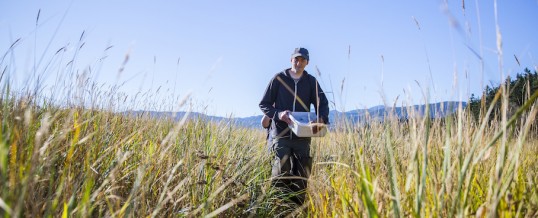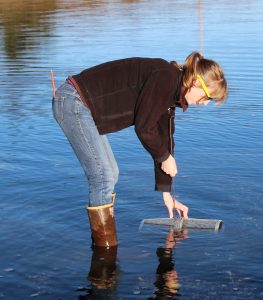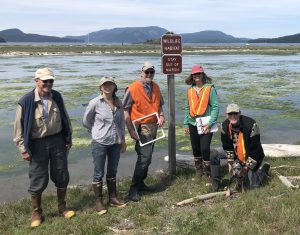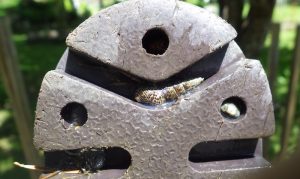
In addition to creating a scientifically robust sampling scheme, and one that is sensitive to finding green crab when they are rare, Crab Team also put a great deal of thought and guidance into the protocol with the goal of being good stewards of Washington’s shorelines. Even though our goal is to detect green crab as they first arrive and help avoid ecological damage, it is certainly true that the act of sampling itself can be a disturbance to a site. Repeated visits to muddy habitats can trample vegetation over time. Being caught in a trap can be stressful for the native crabs and fish. Multiply this by 56 sites, six times per year over successive years, and the cumulative effects, if we weren’t careful, could be substantial, and even reduce the resilience of sites to green crabs.
We wanted to highlight those best practices for sampling that aim to protect the habitat from being impacted by the work we do.
Taking care of the animals
We set traps targeting green crabs, but the vast majority of what we catch is native crabs, shrimps, fishes, and other assorted critters. Even though everything in our traps is released as soon as it is counted (except green crabs, of course!), trapping can still be stressful for these animals – imagine being a sculpin and sharing your trap with several hundred beefed up male hairy shore crabs who have been promised a fish dinner. So that we can release animals in the best condition possible, and they can continue to contribute to the rich and productive pocket estuaries of the Salish Sea:

Emily demonstrates setting traps in places so they are always underwater, even on the lowest low tides. Photo: J. Adams
- Set traps where they will be underwater the entire time. We often choose sites with a sill, or pools that retain water even on very low tides. This means the traps should still be under water during an overnight higher-low tide, so any fish that have been caught aren’t left high and dry.
- Reduce time animals spend in traps. Volunteers are encouraged to retrieve traps as soon as the next day’s tide drops low enough to get to the traps – this might be well before the lowest tide of the day since some of the traps will be accessible at tides that aren’t very low. We never leave traps unchecked for more than 24 hours.
- Focus on an early release time, especially in times and places when water is warm. Warm water holds less oxygen than cold water, and a crowded trap can deplete the oxygen in a small pool rapidly. During warmer months and on sunny days the temperature at shallow sites can get quite warm, so an early morning trap retrieval is particularly important in the summer.
- Handle animals with care. The fish and crabs in traps are focused on survival, and don’t always make this step easy for volunteers. But in general, touch fish as little as possible, to avoid damaging their protective slime coating, and release them immediately after they are photographed and counted, before measuring crabs. Use bins, rather than your hands, to move fish, gently scoop or pour them, rather than stunning them by dumping or throwing them back. Crabs cling to the trap mesh, making removal difficult, and it’s important to avoid pulling too hard which could cause them to lose claws. If the damage is manageable (read about claw loss), crabs can regrow their limbs over a few molt cycles, but losing a claw makes it much harder for them to make a living in the meantime and can reduce their chances of survival. We recommend as much patience as you can muster. Offer clingy crabs a better choice than your finger or the trap. Pulling on them always makes them pinch down even harder, but if you hold in water near a safe refuge, they’ll often choose to let go and retreat on their own.
- Release animals in a safe place. The somewhat disoriented and stressed animals are surely relieved to be put back in the water, but until they get their bearings, they can be an easy target for a gull or other predator. And depending on the location, the tide might not come back up to the site where the traps was for several hours! Make sure animals, especially fish, get back to cool, relatively deep water, with some burrows or structure to offer protection and wait out the return of the tide.
Stewarding the sites
Many of the Crab Team monitoring sites are beautiful salt marshes and pocket estuaries, and some are in public parks with visitors who appreciate the natural setting. The sites have cultural and economic value that could be degraded by “too much love,” and provide important ecosystem services such as erosion control and foraging ground. To preserve the habitat:
-

Volunteers at Spencer Spit State Park have permission to work in the lagoon, which is off limits to park visitors. Wearing orange vests helps signal that the group is at work on behalf of the park! Photo: E. Grason
Use existing trails where possible, and be aware of trampling to avoid excess vegetation damage. All Crab Team sites involve some “off roading” but consolidating the walking to a routine trail helps keep the overall footprint of impacts small. Take note of and avoid walking through sensitive areas with shellfish or other animals.
- Prevent “permissive site access” by public. Crab Team volunteers often get permission to work at special sites where the public are generally not allowed to protect the habitat. But visitors to sites might see volunteers and think that the restricted areas are fair game. Wearing vests while sampling, and using signage can help notify the public while you are on site that you are at work. Or, if it’s appropriate, put up a sign that indicates you have obtained permission to work in sensitive areas.
- Remove used bait from site. A pile of mackerel on the beach poses a number of problems. Most of the sites sampled are low energy, so the large biomass of decaying fish likely won’t wash away quickly, and may attract animals like raccoons and birds to the site. If these animals come to expect a monthly smorgasbord, they may start trying to help themselves while the bait is still in the trap.
Avoiding becoming vectors
Many Crab Team volunteers engage in other beach-y activities, and it’s important to reduce the chance that plants and animals could be moved from place to place. While it’s unlikely anyone could accidentally transport a green crab in the tread of their boots, other organisms are ready stowaways, such as the seeds of invasive Spartina, small mud snails, etc. We’re not as worried about accidentally moving the animals we can see, we’re more worried about the ones we can’t see.

A stowaway invasive Asian mud snail (Batillaria attramentaria) in a boot tread. These snails are only spread by humans, so make sure you don’t offer them a lift!
- Clean boots. No matter your site or activity, always thoroughly clean your boots or waders before visiting another site. Get all of the caked mud out from treads and crevices. Remove as much as possible before leaving the actual site, then complete the cleaning using freshwater and a brush at least 100 yards upland from any shoreline. Ideally, allow gear (especially waders) to fully dry for several days before using at another site.
- Quarantine sampling gear. All Crab Team gear is restricted to use at a single site. That is, no traps or other gear should be used at multiple sites without special dispensation and decontamination.
- Compost used bait upland. As described above, dumping used bait (or reusing as crab bait) elsewhere, could bring diseases or animals that are too small to see from the sampling site to other shorelines they may or may not already inhabit.
You are likely already doing most, if not all, of these things, and we appreciate all the extra extra things you do – like picking up trash – to be great stewards of your sites! Following all of these tips helps ensure that we can continue to monitor our Crab Team sites in the years to come.
Header Photo: UW College of the Environment
NOV
2019